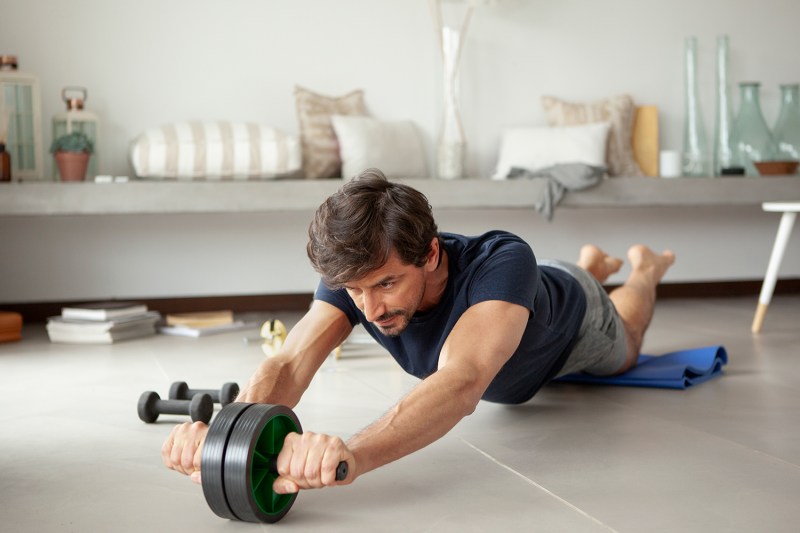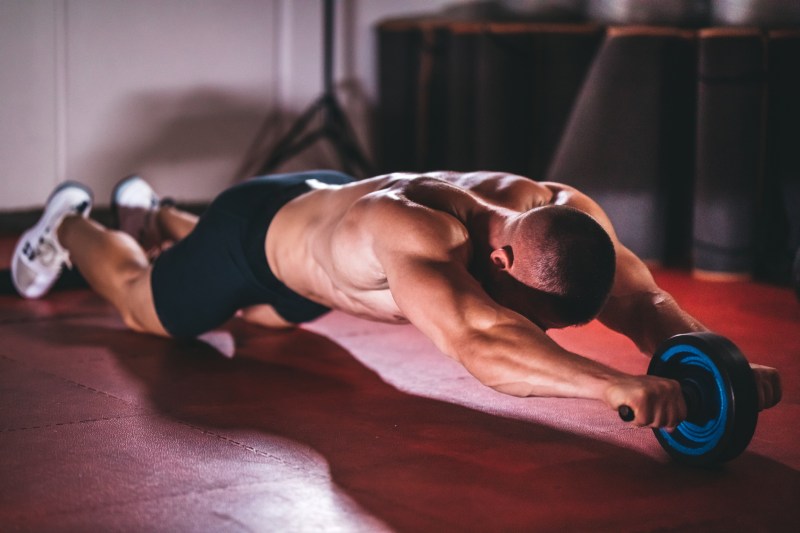Are you looking to chisel your abs for that neck-turning look? If so, an ab roller is the ideal piece of equipment for you. The roller is crafted in a simple design to help you tone your midsection and build a stronger, well-defined core. With consistent use, you get the chance to gain balance and stability as well as you get fit overall.
In this piece, we’ll dive into the world of the ab roller, its benefits, downsides, and how you can use it for core strengthening.
What is an ab roller?

An ab roller, also called an ab wheel, is a gym tool consisting of a single or double wheel with two handles shooting out from either side of the wheels. It requires strength, balance, and control, making it the ideal equipment for building a stronger core.
Although this equipment is designed to look simple, it can be quite challenging to use, especially if you are a beginner. But by mastering the techniques, you will be good to go.
What muscles does an ab roller target?

The ab roller primarily targets multiple muscle groups, such as the core muscles, which include the abdominal, back, and pelvic muscles, but most especially the abdominals. Regarding the anterior abdominal wall, the ab roller targets the rectus abdominis, commonly known as the “six-pack” muscle.
Other muscles engaged while using the ab roller include the transverse abdominis muscles, the obliques, the erector spinae, and the hip flexors. These muscles contribute to movements involving the trunk and hips.
What are the benefits of using an ab roller?

The primary benefit of using an ab roller is core strengthening. The rolling and stretching movements associated with this exercise activate and increase the mass of the core muscles. Beyond getting you a strong core, other benefits of the ab roller include the following:
- Improved posture: An important benefit of having a stronger core is that it comes with a better posture, which reduces stress on the spine and helps alleviate back pain.
- Better muscle activation: Using the ab roller helps you activate your muscle fibers more than you would while doing regular exercises. Muscle activation while using the ab roller helps you gain muscle mass in your core or other muscles worked on.
- Enhanced balance and stability: Consistent ab roller use can improve balance and stability, which are crucial for daily activities as well as athletic performance.
- Improved overall fitness: Ab roller workouts mirror everyday movements, making your muscles more functional and resilient. Therefore, it improves the body’s overall fitness.
- Helps prevent injuries: A strong and well-defined core ensures that your spine is stabilized and less prone to injury, especially during twisting and turning movements. Your abdominal muscles are kept firm, protecting your internal organs as well.
- Increases efficiency level: By engaging multiple muscle groups during your workout with an ab roller, you get a more comprehensive workout in less time.
- Creates progressive challenge: As you build strength, you can increase the rolling distance or reps to continually challenge yourself and improve. Gradually, you will move from being a beginner to an advanced trainer.
Are there any downsides to the ab roller?

Although the ab roller offers several benefits, it also has its downsides.
- Risk of injury: You stand a risk of straining your shoulders and lower back if you don’t maintain correct form while using the ab roller or if you overextend.
- Challenging for beginners: The ab roller requires deep core strength and stability, making it challenging for beginners still learning to roll out.
- May be difficult to use: Considering the strength and technique needed, the ab roller can be difficult to master, leading to frustration for some users.
How to use an ab roller

Instructions:
- Get a yoga mat and kneel on it. It is important to use a mat to ensure comfort for your kneecaps.
- With the ab roller in front of you, grab the handles, ensuring your position is balanced. Your arms should be fully extended.
- As though you are taking a breath, draw your belly button toward your spine.
- Still holding the handles, gently extend your upper body and roll the wheel forward while maintaining proper form.
- Hold that position for a few seconds to stretch and activate the muscle fibers.
- Slowly roll the wheel back to the starting position with your core engaged and in proper form.
Recommended sets and reps:
- Beginner: 1-2 sets of 5-8 reps
- Intermediate: 2-3 sets of 8-12 reps
- Advanced: 3-4 sets of 10-15 reps
Pro tips:
- Before you get into the rollouts, you should warm up first. Warming up by doing stretches helps to prepare your muscles and prevent injuries such as muscle strain.
- Using the ab roller with a proper form is as important as the exercise itself. You should exercise with your back straight and avoid arching. This helps eliminate the risk of lower back strain.
- Remember to rest periodically while exercising. This allows you to recover with enough energy for the next reps. Over-exercising will only lead to fatigue and injury.
- Be careful not to overextend when you roll out. It is better to limit your range of motion, especially as a beginner. Only roll out as far as you can while still in proper form.
- Using a mat provides you with adequate cushioning and comfort for your knees.
How often should you use an ab roller to see results?

You should use the ab roller two to three times weekly for noticeable results. While you use the ab roller, try to include other core exercises in your workout routine to maximize progress. If you are consistent, you should start seeing results in about four to six weeks, depending on your fitness level.
Frequently asked questions

Is the ab roller effective for belly fat?
You cannot target belly fat, so while the ab roller does tone the midsection by contributing to muscle mass, it does not directly help with belly fat. However, these exercises, when paired with a calorie deficit and living a healthy lifestyle, can help you lose belly fat.
Is the ab roller better than situps?
When it comes to engaging the core muscles, the ab roller appears to be more effective than the situp exercise. This is because using the ab roller requires more balance and stability while targeting the deep core muscles. Situps mostly engage the rectus abdominis, which is more superficial compared to other deep-seated muscles worked by the ab roller, making it an ideal gym tool for core development.
Do ab rollers give you a six-pack?
Ab rollers can give you a six-pack as they define your rectus abdominis muscle and increase the muscle mass. However, you need a low percentage of belly fat to pull this off by eating in a calorie deficit.




